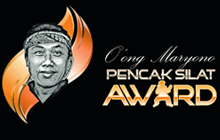Rapid Journal
Vol.7
No.3
(Book 25
2003: 46)
Under the leadership of Mr. Wongosonegoro (1948-1973), Tjokopranolo (1973-1978) and Eddie M. Nalapraya (1978-2003), and with the support of the government and President Soeharto as…
Rapid Journal
Vol.7
No.2
(Book 24
2002: 44, 37)
In the previous edition, we have seen how the founders and board members of IPSI aimed at standardizing ‘pencak silat’ on the assumption that its…
Rapid Journal
Vol.7
No.1
(Book 23
2002: 40-41, 39)
In the previous edition, I concluded by mentioning that on December 21-23, 1950, the second IPSI congress was held in Yogyakarta to strengthen the organization…
Rapid Journal
Vol.6
No.4
(Book 22
2002: 38-39)
Efforts to revamp pencak silat were badly needed in the early years of the Republic. Manyperguruan were no longer functioning, and many leaders and masters…
Rapid Journal
Vol.6
No.3
(Book 21
2002: 36 – 38)
At the outset of the Japanese occupation, the military authority banned all socio-cultural activities (including pencak silat) that might endanger its future existence. Only after…
Rapid Journal
Vol.6
No.2
(Book 20
1999: 42 – 43)
The reputation of pencak silat began to improve in the early 20th century with the emergence of the Etische Politiek or Ethical Policy, which aimed…
Rapid Journal
Vol.6
No.1
(Book 19
2001: 40 – 41)
Discussion of pencak silat during the time of the Dutch-East Indies would not be complete without bringing up the issue of ‘jago’: a pencak silat…
Rapid Journal
Vol.5
No.4
(Book 18
2001: 42 – 43)
At the beginning of the colonial period, pencak silat continued to expand to all outlying areas of the archipelago, as a result of greater, large-scale…
Rapid Journal
Vol.5
No.3
(Book 17
2001: 37 – 39)
Beginning in 1598, Dutch traders came to the islands of the archipelago and tried to gain control of the spice trade, competing with local authorities…
Rapid Journal
Vol.5
No.2
(Book 16
2000: 35 – 37)
Changes in the function of pencak silat came about in line with the gradual transformation of it surrounding society, and was initiated in the two…
Rapid Journal
Vol.5
No.1
(Book 15
2000: 40 – 41)
Continuing our travel through time, it is important to pose to discuss the Majapahit Empire, between the XIII and the XVI century, since this was…
Rapid Journal
Vol.4
No.4
(Book 14
2000: 40 – 41)
As we discussed in the previous article (O’ong Maryono 1999:38-39), Malay myths concur that pencak silat was originally developed by tribal groups in the archipelago…
Rapid Journal
Vol.4
No.3
(Book 13
1999: 38 – 39)
It is not easy to trace back the history of pencak silat because written documentation is limited and oral information handed down from the guru…
Rapid Journal
Vol.4
No.2
(Book 12
1999: 38 – 39)
Many of the readers may wonder what pencak silat actually is. In the Philippines, with its many martial arts forms, pencak silat is still relatively…
Before beginning the discussion of jago and the role they played in the colonial period, we must first explore the meaning of the term “jago”…
That day was the end of Pitung’s life, but because of his good deeds towards those in need, Pitung will always be remembered as the…
Adapted from Notosuyitno in ‘Miscellaneous Pencak Silat’ 1999:28-30. Pencak Silat competition is one of the means to perpepuate, develop and socialize pencak silat and to…
According to the Bahasa Indonesia dictionary, ‘guru’ is a person who has teaching as profession. ‘maha‘ originally derives from Sanskrit, meaning ‘great/big’. Therefore ‘mahaguru‘ is synonym of…
Life of Pak Kahir (An excerpt translated from Gema Pencak Silat Vol.3 No. 1:18-19) The founder of Silat Cimande, Pak Kahir, first became known as…
“Kuntao is not self-defense”. This sentence may sound strange to us, but according to Liem Yoe Kiong (1960:215) it has some value if the name…
